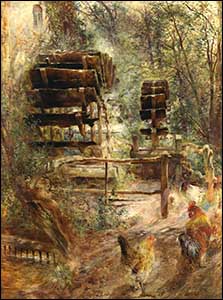Marford Mill, Rossett
Marford Mill, Chester Road, Rossett
 The building beyond the car park is Marford Mill. It’s private property so please enjoy the view from road. You can see the waterwheels clearly from the bridge over the millstream.
The building beyond the car park is Marford Mill. It’s private property so please enjoy the view from road. You can see the waterwheels clearly from the bridge over the millstream.
A mill in this vicinity was recorded in the Domesday Book of 1086. The mill which stood here by the early 15th century was destroyed by the rebel forces of Owain Glyndŵr.
The mill – belonging to the Crown – was rebuilt, and all villeins in the area had to take their grain there for milling. (Villeins, or unfree tenants, served the local landowner and had fewer rights than free tenants.) This was an unpopular arrangement and in 1544 a rival new mill was erected on the opposite side of the road.
Both mills were then in the township of Marford. They were probably known as the upper and lower Marford Mills. Rossett was only a small hamlet at the time. The upper mill became known as Rossett Mill after a boundary change removed it from Marford.
The lower mill was wrecked by fire in the 18th century and much of the building we see today was erected on the old foundations. Unusually the mill has two waterwheels, almost side by side. They drove separate sets of machinery. The painting of the wheels shown here, by kind permission of The Maas Gallery in London, is by William Huggins (1820-1844).
In 1902 the press reported that a storm had blown down a “huge walnut tree” near Marford Mill. The tree had been a landmark, “possibly for several hundred years”.
In the 1970s the derelict mill was converted into offices. Since the 1980s it has housed the offices of the British Association for Shooting and Conservation, which renamed it the Stanley Duncan Building. Stanley Duncan founded the BASC’s predecessor, the Wildfowlers’ Association of Great Britain and Ireland, in 1908, partly in response to wildfowl habitat being lost as more coastal land was drained to form farmland.
Postcode: LL12 0HL View Location Map

